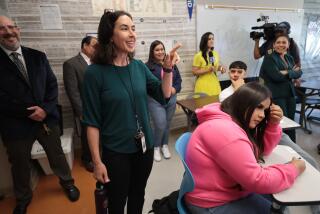Little Pleasures Put the Shine on Teachers’ Apples
- Share via
It was the day of their pep rally, so the more than 500 South Bay teachers who attended back-to-school ceremonies at Lawndale’s Leuzinger High last week were pumped up and rarin’ to go.
State School Supt. William Honig, who had come from Sacramento to speak to the teachers, filled them with a New Frontier-ish sort of enthusiasm, holding out the promise of challenge and hard work as though it were stock in a diamond mine.
Afterward, half a dozen teachers gathered in an empty classroom to talk to a reporter about the prospects of beginning yet another school year, of confronting yet another roomful of blank slates, of informing yet another batch of students that throwing spitballs is not a designated school sport.
But teacher burn-outs--those in whom the fire of devotion has long since died--were nowhere to be seen at this round-table. Whether Honig had rekindled their ardor or whether it simply had never flickered, these teachers seemed honestly excited about the prospect of getting back to the classroom.
“I just love this age group,” said counselor Nancy Roos of her students at Hawthorne High School. “They have a vitality, an enthusiasm that’s very contagious. They’re still searching, looking for happiness. There’s a freshness about them that helps keep me young. I know it sounds corny, but I really do look forward to the beginning of every school year.”
As snatches of the lively discussion drifted into the halls, curious teachers poked their heads in the doorway and quickly joined in.
Soon, nearly two dozen were excitedly debating the merits of teaching, the school system, children, parents, programs, problems, triumphs--you name it.
“Every year I start all over again to teach 371 English-language endings versus 10 in Spanish,” said a clearly enthusiastic Judy Ibarra, a third-grade bilingual teacher at Lawndale’s Anderson Elementary school.
But enthusiasm aside, how does this modern-day Sisyphus motivate herself to roll the proverbial rock up the hill year after year, only to find herself back at the bottom every September?
“I don’t look at it like, ‘Here’s another bunch of kids that don’t know anything.’ I see it as a challenge. I have visions of those who left in June knowing.”
“Asking why we do it every year, that’s like asking Chrissy (Evert) why she plays another Wimbledon,” chimed in Esperanza Andrade-Banachowski, a pre-first-grade teacher at Whelan Elementary School in Lennox.
Pre -first grade? You mean kindergarten?
“No,” she said, chuckling. “This is after kindergarten, for kids who need a transition between kindergarten and first grade.” Oh.
Some students need transitions of a different kind.
Talking about the rewards and challenges of teaching the South Bay’s growing number of immigrant children, 30-year teaching veteran Darlene Ferguson related how she was “shocked into reality” by a couple of her Salvadoran students.
“They were so bored and restless in class, I couldn’t control them,” Ferguson said, to sympathetic nods and murmurs. “Then I found out they had been in the Salvadoran army before they got here. One of them showed me the bullet hole in his neck. They were 14.
“Kids like that really make me see the world differently. I have to think not only about how to teach them, but how to help them adjust to such a different world. That’s a challenge.”
Phil O’Connor, a drama teacher at Leuzinger, observed that teaching sometimes requires “the dedication of a nun.” “They ask somebody to get two degrees, work like a dog, have the patience of a saint, the energy of 10 people, and then they tell you the most you’ll make is $24,000.”
Why do it?
“I think we were born to be teachers,” O’Connor said. “Teachers have a strong feeling to be needed. Maybe we never really were done with school ourselves.”
Andrade-Banachowski was more pragmatic. “We like to talk,” she said, as the roomful of teachers burst into laughter.
That much became apparent as teachers chattered and laughed and waved their hands to be recognized, feeding off the energy the discussion generated, pausing only when they realized how much they resembled their own students.
“I guess we get pretty excited talking like this,” said Ibarra, momentarily abashed. “Sometimes I know people don’t believe it, but I think most of us really do love our work. It’s not just teaching. It’s little things.”
She got no further. That set off another tidal wave of raised hands as each teacher contributed a “little thing.”
“You laugh at their little jokes and you hold them when they cry,” Andrade-Banachowski said.
“You go to weddings, funerals, christenings, quinceanos, “ said Ferguson, referring to the traditional Latino “coming out” party that marks a girl’s 15th birthday.
“I remember a student from Tonga who named her first child Leuzinger,” O’Connor said. “Thank God the first one was a boy.”
“I remember a girl who was trying to learn English,” said Rita Assaf, who teaches English as a second language for the Centinela Valley school district. “She cried almost every day out of frustration and because of personal problems. I saw her again in a supermarket years later and she spoke beautiful, perfect English, had a good job, and thanked me for the help I gave her. Those are the moments you can’t measure. That’s what makes it worth coming back every year.”
More to Read
Sign up for Essential California
The most important California stories and recommendations in your inbox every morning.
You may occasionally receive promotional content from the Los Angeles Times.













